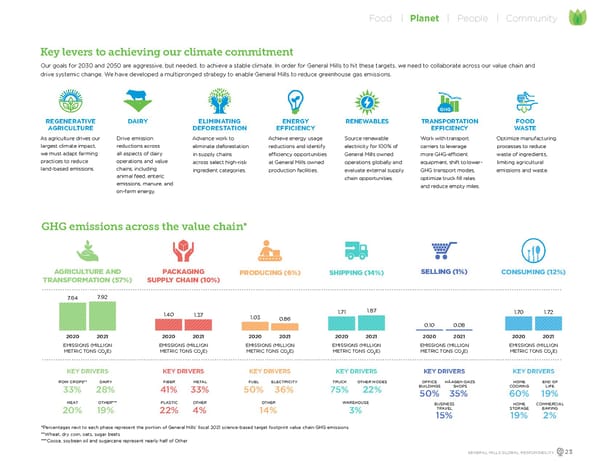*Percentages next to each phase represent the portion of General Mills’ fiscal 2021 science-based target footprint value chain GHG emissions **Wheat, dry corn, oats, sugar beets *** Cocoa, soybean oil and sugarcane represent nearly half of Other CONSUMING (12%) SELLING (1%) SHIPPING (14%) KEY DRIVERS WAREHOUSE 3% TRUCK 75% OTHER MODES 22% PRODUCING (6%) KEY DRIVERS FUEL 50% 36% ELECTRICITY 14% OTHER PACKAGING SUPPLY CHAIN (10%) KEY DRIVERS METAL 33% FIBER 41% OTHER 4% PLASTIC 22% AGRICULTURE AND TRANSFORMATION (57%) KEY DRIVERS DAIRY 28% ROW CROPS** 33% MEAT 20% 19% OTHER*** EMISSIONS (MILLION METRIC TONS CO 2 E) GHG emissions across the value chain * KEY DRIVERS BUSINESS TRAVEL 15% HÄAGEN-DAZS SHOPS 35% OFFICE BUILDINGS 50% KEY DRIVERS HOME COOKING 60% HOME STORAGE 19% END OF LIFE 19% COMMERCIAL BAKING 2% EMISSIONS (MILLION METRIC TONS CO 2 E) 0.08 0.10 2021 2020 EMISSIONS (MILLION METRIC TONS CO 2 E) 1.87 1.71 2021 2020 EMISSIONS (MILLION METRIC TONS CO 2 E) 1.72 1.70 2021 2020 EMISSIONS (MILLION METRIC TONS CO 2 E) 0.86 1.03 2021 2020 EMISSIONS (MILLION METRIC TONS CO 2 E) 1.37 1.40 2021 2020 2021 2020 7. 9 2 7.64 As agriculture drives our largest climate impact, we must adapt farming practices to reduce land-based emissions. Drive emission reductions across all aspects of dairy operations and value chains, including animal feed, enteric emissions, manure, and on-farm energy. Advance work to eliminate deforestation in supply chains across select high-risk ingredient categories. Achieve energy usage reductions and identify efficiency opportunities at General Mills owned production facilities. Source renewable electricity for 100% of General Mills owned operations globally and evaluate external supply chain opportunities. Work with transport carriers to leverage more GHG-efficient equipment, shift to lower- GHG transport modes, optimize truck fill rates and reduce empty miles. Optimize manufacturing processes to reduce waste of ingredients, limiting agricultural emissions and waste. Our goals for 2030 and 2050 are aggressive, but needed, to achieve a stable climate. In order for General Mills to hit these targets, we need to collaborate across our value chain and drive systemic change. We have developed a multipronged strategy to enable General Mills to reduce greenhouse gas emissions. DAIRY Key levers to achieving our climate commitment REGENERATIVE AGRICULTURE ENERGY EFFICIENCY FOOD WAST E TRANSPORTATION EFFICIENCY RENEWABLES ELIMINATING DEFORESTATION GHG GENERAL MILLS GLOBAL RESPONSIBILITY 23 Food Planet People Community
 GeneralMills Global Responsibility Report Page 24 Page 26
GeneralMills Global Responsibility Report Page 24 Page 26